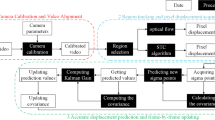Abstract
The streak camera is an ultra-fast diagnostic instrument with high sensitivity, and a high temporal and spatial resolution. It is primarily employed in various scientific research, such as inertial confinement fusion (ICF), synchrotron light sources, and electron–positron colliders. An automatic control system for an X-ray streak camera is presented in this paper. The output terminal of an analog-to-digital converter was isolated from its input terminal, to reduce interference from high-voltage electrodes. Compared with traditional methods, this scheme also improved the internal electromagnetic interface immunity. Therefore, the system stability was enhanced. With this optimized control system, some characterizations of the streak camera were measured. Static and dynamic spatial resolutions of 25 and 20 lp/mm (CTF = 20%), respectively, were obtained. In addition, a dynamic range of 552:1 and a temporal resolution of 7.3 ps were achieved. The results confirmed that these characterizations are sufficient for the specifications derived from the diagnostic requirements of ICF.
















Similar content being viewed by others
References
S.F. Khan, J.J. Lee, N. Lzumi et al., Characterization of the X-ray sensitivity of a streak camera used at the National Ignition Facility (NIF), in Proceedings of Target Diagnostics Physics and Engineering for Inertial Confinement Fusion II, San Diego, USA, 27–28 Aug 2013. https://doi.org/10.1117/12.2024555
S.F. Khan, P.M. Bell, D.K. Bradley et al., Measuring x-ray burn history with the Streaked Polar Instrumentation for Diagnosing Energetic Radiation (SPIDER) at the National Ignition Facility (NIF), in Proceedings of Target Diagnostics Physics and Engineering for Inertial Confinement Fusion, San Diego, USA, 14 Aug 2012. https://doi.org/10.1117/12.930032
C.P. Welsch, H.H. Braun, E. Bravin et al., Longitudinal beam profile measurements at CTF3 using a streak camera. J. Instrum. 1, P09002 (2006). https://doi.org/10.1088/1748-0221/1/09/P09002
A. Takahashi, M. Nishizawa, Y. Inagaki et al., New femtosecond streak camera with temporal resolution of 180 fs, in Proceedings of Generation, Amplification, and Measurement of Ultrashort Laser Pulses, Los Angeles, USA, 25–27 Jan 1994. https://doi.org/10.1117/12.175863
T. Yanagida, Y. Fujimoto, A. Yoshikawa et al., Development and performance test of picosecond pulse X-ray excited streak camera system for scintillator characterization. Appl. Phys. Express 3, 056202 (2010). https://doi.org/10.1143/APEX.3.056202
N.V. Ageeva, S.V. Andreev, V.P. Degtyareva et al., Sub-100 fs streak tube: computer-aided design, manufacturing, and testing, in Proceedings of 28th International Congress on high-Speed Imaging and Photonics, Canberra, Australia, 9–14 Nov 2008. https://doi.org/10.1117/12.821666
W. Uhring, C.V. Zint, P. Summ et al., Very high long-term stability synchros can streak camera. Rev. Sci. Instrum. 74, 2646–2653 (2003). https://doi.org/10.1063/1.1569409
G.A. Naylor, K. Scheidt, J. Larsson et al., A sub-picosecond accumulating streak camera for X-rays. Meas. Sci. Technol. 12, 1858–1864 (2001). https://doi.org/10.1088/0957-0233/12/11/314
J. Feng, H.J. Shin, J.R. Nasiatka et al., An X-ray streak camera with high spatio-temporal resolution. Appl. Phys. Lett. 91, 134102 (2007). https://doi.org/10.1063/1.2793191
P. Gallant, P. Forget, F. Dorchies et al., Characterization of a subpicosecond X-ray streak camera for ultrashort laser-produced plasmas experiments. Rev. Sci. Instrum. 71, 3627–3633 (2000). https://doi.org/10.1063/1.1310347
J. Liu, Y.K. Ding, J.S. Tian et al., Modular remote-controllable anisotropic focusing streak camera. High Power Laser Part. Beams 24, 2405–2410 (2012). https://doi.org/10.3788/HPLPB20122410.2405. (in Chinese)
V.N. Rai, M. Shukla, H.C. Pant et al., Development of picosecond time resolution optical and X-ray streak cameras. Sadhana-Acad. P. Eng. S. 20, 937–954 (1995). https://doi.org/10.1007/bf02745874
Z.C. Tan, M. Mueck, X.H. Du et al., A fully isolated delta-sigma ADC for shunt based current sensing. IEEE J. Solid State Circuits 51, 2232–2240 (2016). https://doi.org/10.1109/JSSC.2016.2581800
J.W. Yang, T.S. Li, T. Yi et al., Electromagnetic pulses generated from laser target interactions at Shenguang II laser facility. Plasma Sci. Technol. 18, 1044–1048 (2016). https://doi.org/10.1088/1009-0630/18/10/13
P. Bell, D. Lee, A. Wooton et al., Target area and diagnostic interface issues on the National Ignition Facility, in Proceedings of 13th Topical Conference on High-Temperature Plasma Diagnostics, Tucson, USA, 18–22 June 2000. https://doi.org/10.1063/1.1310582
X.H. Chen, X.X. Xie, C.S. Gao et al., Design and implementation of the BESIII detector-control system. Nucl. Instrum. Methods A 592, 428–433 (2008). https://doi.org/10.1016/j.nima.2008.04.072
G.H. Chen, J.F. Chen, T.M. Wan et al., Database application research in real-time data access of accelerator control system. Nucl. Sci. Tech. 23, 267–271 (2012). https://doi.org/10.13538/j.1001-8042/nst.23.267-271
Q.B. Yuan, M. Gu, R.P. Wang et al., The control system for SSRF injection and extraction. Nucl. Sci. Tech. 18, 326–329 (2007). https://doi.org/10.1016/S1001-8042(08)60002-0
J. Yan, R. Liu, C. Li et al., LabVIEW-based auto-timing counts virtual instrument system with ORTEC 974 Counter/Timer. Nucl. Sci. Tech. 20, 307–311 (2009). https://doi.org/10.13538/j.1001-8042/nst.20.307-311
P. Liu, Y. Wang, R.Z. Tai et al., Implementation of effective control system for variable-included angle plane-grating monochromator. Nucl. Sci. Tech. 22, 9–12 (2011). https://doi.org/10.13538/j.1001-8042/nst.22.9-12
B.K. Chung, A experiment on the layout and grounding of power distribution wires in a printed circuit board. IEEE Trans. Edu. 44, 315–321 (2001). https://doi.org/10.1109/13.965778
R. Kliger, Integrated transformer-coupled isolation. IEEE Instru. Meas. Mag. 6, 16–19 (2003). https://doi.org/10.1109/MIM.2003.1184271
J.C. Candy, A use of double integration in sigma delta modulation. IEEE Trans. Commun. 33, 249–258 (1985). https://doi.org/10.1109/TCOM.1985.1096276
Author information
Authors and Affiliations
Corresponding author
Rights and permissions
About this article
Cite this article
Fang, YM., Xu, XY., Tian, JS. et al. Design of a control system with high stability for a streak camera using isolated ADC. NUCL SCI TECH 29, 22 (2018). https://doi.org/10.1007/s41365-018-0361-9
Received:
Revised:
Accepted:
Published:
DOI: https://doi.org/10.1007/s41365-018-0361-9




